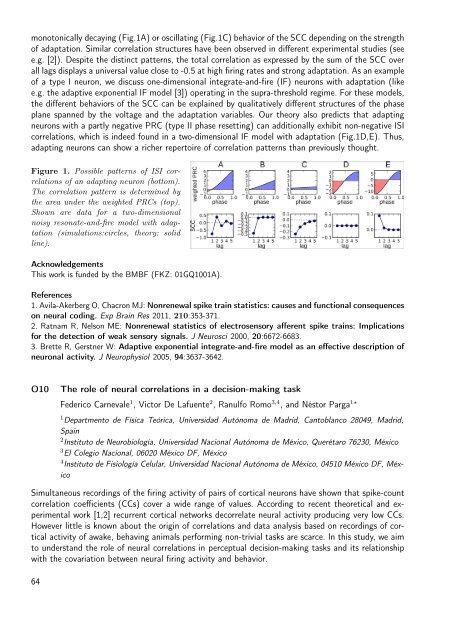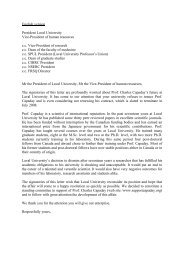Untitled - Laboratory of Neurophysics and Physiology
Untitled - Laboratory of Neurophysics and Physiology
Untitled - Laboratory of Neurophysics and Physiology
Create successful ePaper yourself
Turn your PDF publications into a flip-book with our unique Google optimized e-Paper software.
monotonically decaying (Fig.1A) or oscillating (Fig.1C) behavior <strong>of</strong> the SCC depending on the strength<br />
<strong>of</strong> adaptation. Similar correlation structures have been observed in different experimental studies (see<br />
e.g. [2]). Despite the distinct patterns, the total correlation as expressed by the sum <strong>of</strong> the SCC over<br />
all lags displays a universal value close to -0.5 at high firing rates <strong>and</strong> strong adaptation. As an example<br />
<strong>of</strong> a type I neuron, we discuss one-dimensional integrate-<strong>and</strong>-fire (IF) neurons with adaptation (like<br />
e.g. the adaptive exponential IF model [3]) operating in the supra-threshold regime. For these models,<br />
the different behaviors <strong>of</strong> the SCC can be explained by qualitatively different structures <strong>of</strong> the phase<br />
plane spanned by the voltage <strong>and</strong> the adaptation variables. Our theory also predicts that adapting<br />
neurons with a partly negative PRC (type II phase resetting) can additionally exhibit non-negative ISI<br />
correlations, which is indeed found in a two-dimensional IF model with adaptation (Fig.1D,E). Thus,<br />
adapting neurons can show a richer repertoire <strong>of</strong> correlation patterns than previously thought.<br />
Figure 1. Possible patterns <strong>of</strong> ISI correlations<br />
<strong>of</strong> an adapting neuron (bottom).<br />
The correlation pattern is determined by<br />
the area under the weighted PRCs (top).<br />
Shown are data for a two-dimensional<br />
noisy resonate-<strong>and</strong>-fire model with adaptation<br />
(simulations:circles, theory: solid<br />
line).<br />
Acknowledgements<br />
This work is funded by the BMBF (FKZ: 01GQ1001A).<br />
References<br />
1. Avila-Akerberg O, Chacron MJ: Nonrenewal spike train statistics: causes <strong>and</strong> functional consequences<br />
on neural coding. Exp Brain Res 2011, 210:353-371.<br />
2. Ratnam R, Nelson ME: Nonrenewal statistics <strong>of</strong> electrosensory afferent spike trains: Implications<br />
for the detection <strong>of</strong> weak sensory signals. J Neurosci 2000, 20:6672-6683.<br />
3. Brette R, Gerstner W: Adaptive exponential integrate-<strong>and</strong>-fire model as an effective description <strong>of</strong><br />
neuronal activity. J Neurophysiol 2005, 94:3637-3642.<br />
O10<br />
The role <strong>of</strong> neural correlations in a decision-making task<br />
Federico Carnevale 1 , Victor De Lafuente 2 , Ranulfo Romo 3,4 , <strong>and</strong> Néstor Parga 1⋆<br />
1 Departmento de Física Teórica, Universidad Autónoma de Madrid, Cantoblanco 28049, Madrid,<br />
Spain<br />
2 Instituto de Neurobiología, Universidad Nacional Autónoma de México, Querétaro 76230, México<br />
3 El Colegio Nacional, 06020 México DF, México<br />
4 Instituto de Fisiología Celular, Universidad Nacional Autónoma de México, 04510 México DF, México<br />
Simultaneous recordings <strong>of</strong> the firing activity <strong>of</strong> pairs <strong>of</strong> cortical neurons have shown that spike-count<br />
correlation coefficients (CCs) cover a wide range <strong>of</strong> values. According to recent theoretical <strong>and</strong> experimental<br />
work [1,2] recurrent cortical networks decorrelate neural activity producing very low CCs.<br />
However little is known about the origin <strong>of</strong> correlations <strong>and</strong> data analysis based on recordings <strong>of</strong> cortical<br />
activity <strong>of</strong> awake, behaving animals performing non-trivial tasks are scarce. In this study, we aim<br />
to underst<strong>and</strong> the role <strong>of</strong> neural correlations in perceptual decision-making tasks <strong>and</strong> its relationship<br />
with the covariation between neural firing activity <strong>and</strong> behavior.<br />
64



